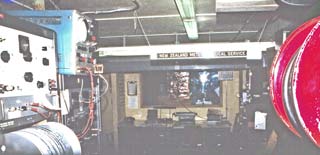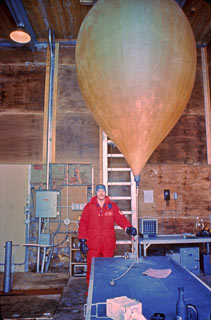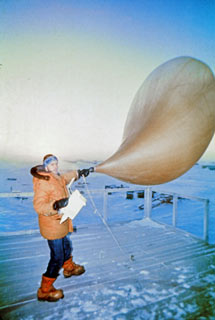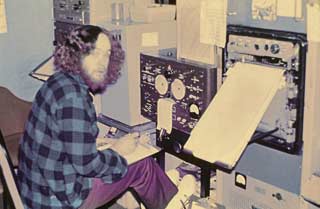Life and science after the closing flight
|

Meanwhile, science never sleeps. Here's a glimpse of the entrance
to the met office, with one end of the seismograph rack on the left. 
Lloyd in the BIT filling a weather balloon with helium. The helium is controlled by a valve connected to a scale calibrated to assure that the balloons will have the same lift characteristics each time.
The helium we used came from gas cylinders which lined the walls of the helium arch below--that was the sole original design purpose of the helium arch, which was actually a late addition to the station design after it was decided to use helium instead of a hydrogen generator. Since there was lots of room, we kept the trash sled there during the winter. At some point after our winter, the cargo operation got too big for our supply office in the annex. They moved to the helium arch, and renamed it. Now in 1999 it's all been displaced by the new garage arch.  Back to 1977, here's Lloyd launching a balloon. The white box is a "radiosonde" which contains a instruments and a radio transmitter to relay the temperature, humidity, pressure (altitude) etc. Plus, the upper air wind speed and direction could be measured by tracking the position of the radiosonde, which is what the "GMD" in the radome on top of BIT was for. Balloons were launched about 1030 local time every day all year; the intent was to have them at or near maximum altitude at 0000 UT or noon our time. During the summer and during flight operations, a second launch was done at 2230 local time.
Back to 1977, here's Lloyd launching a balloon. The white box is a "radiosonde" which contains a instruments and a radio transmitter to relay the temperature, humidity, pressure (altitude) etc. Plus, the upper air wind speed and direction could be measured by tracking the position of the radiosonde, which is what the "GMD" in the radome on top of BIT was for. Balloons were launched about 1030 local time every day all year; the intent was to have them at or near maximum altitude at 0000 UT or noon our time. During the summer and during flight operations, a second launch was done at 2230 local time.
There was an intercom system between the BIT deck and the met office. When Lloyd launched a balloon, he would call out the azimuth and elevation angles so that Simon could aim the tracking antenna and capture the radio signal. Somewhere downwind of here there must be thousands of dead balloons and white boxes buried in the snow. I've heard stories about field parties finding one. Pole was still using these boxes in the late 1980's; I wonder about nowadays. 
On another day, here's Stu's picture of the action from the ground. This may be from early spring, note the drifts around the buried D8 and the closed doors on the helium arch. 
Here's Simon in met watching the tracker. |

